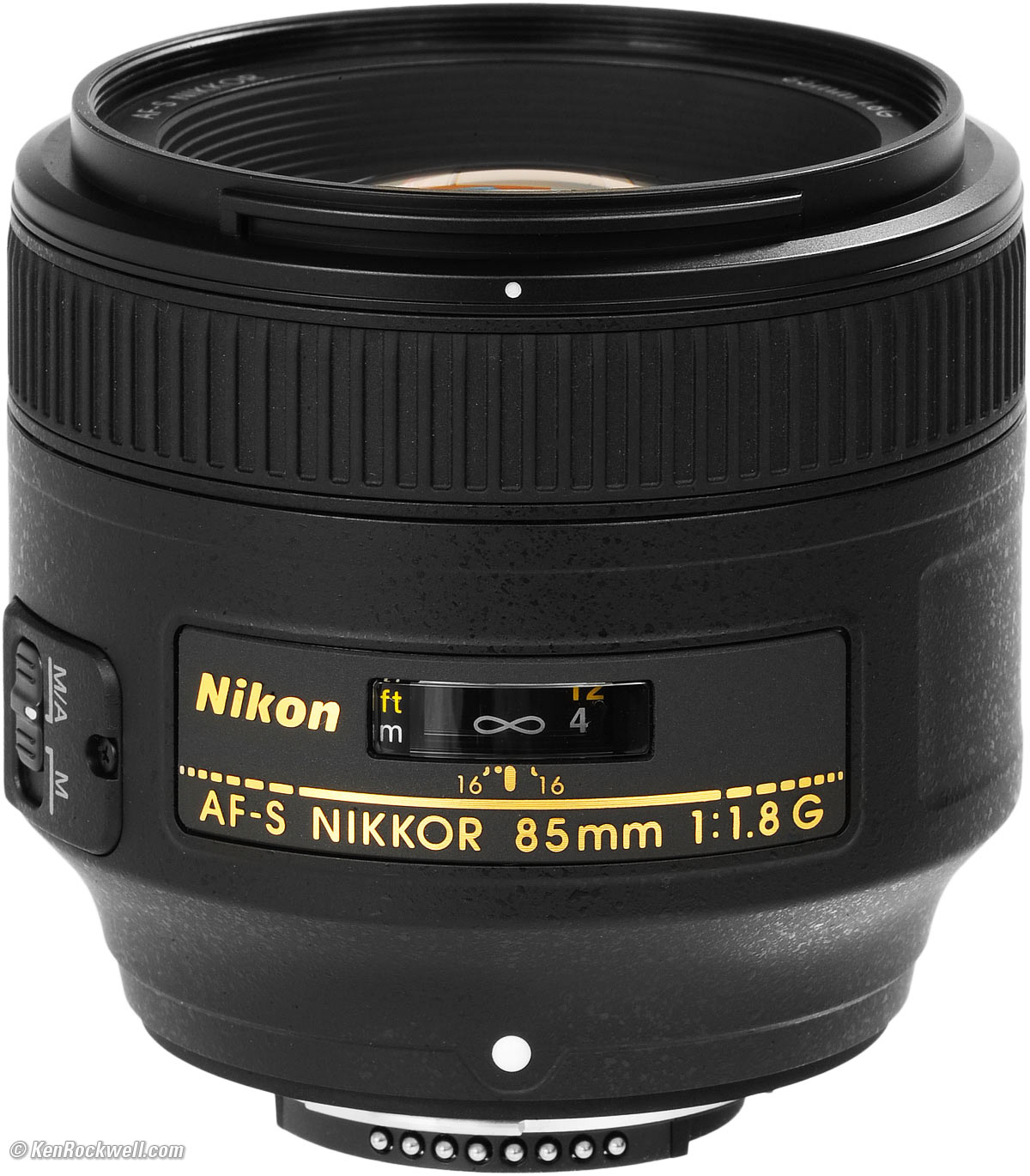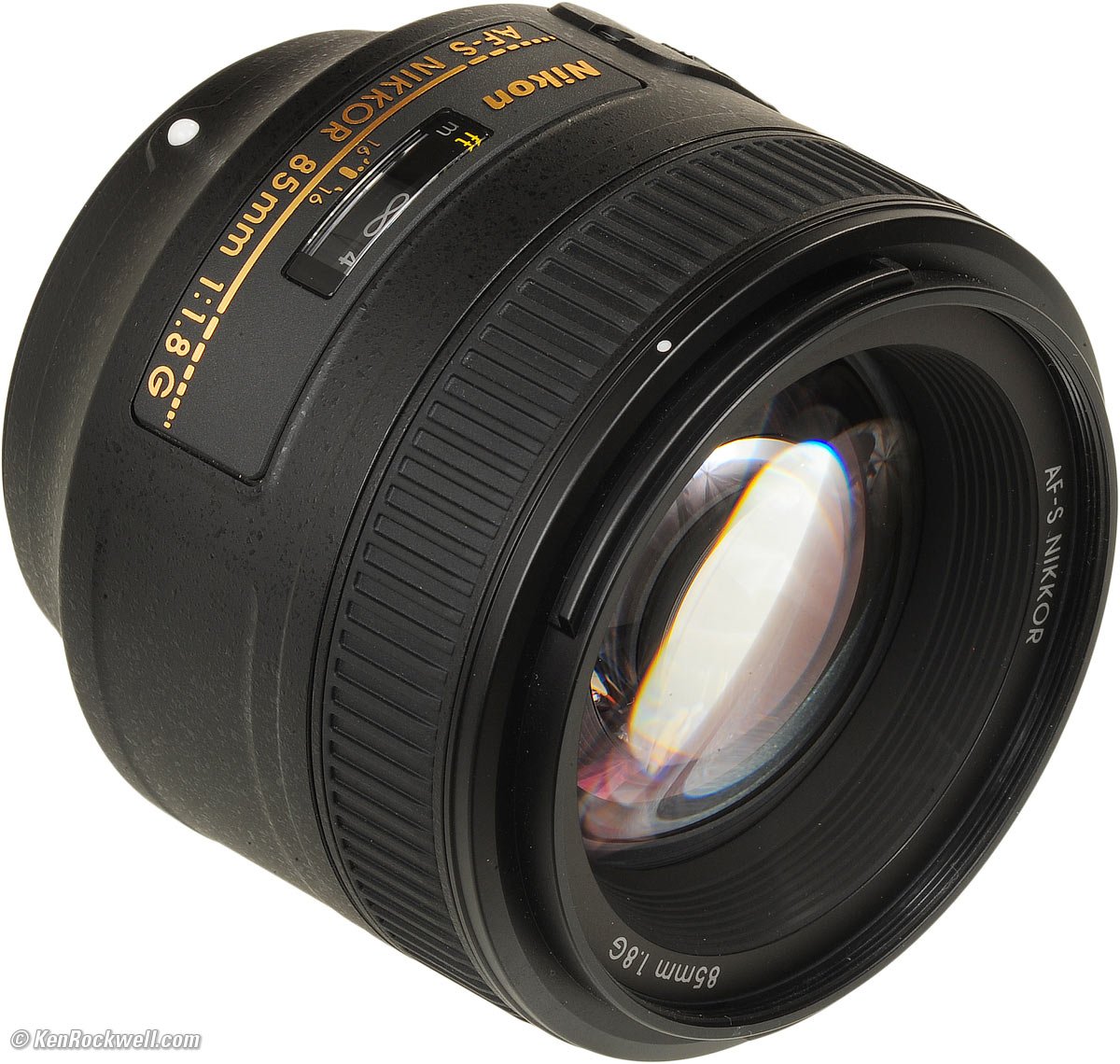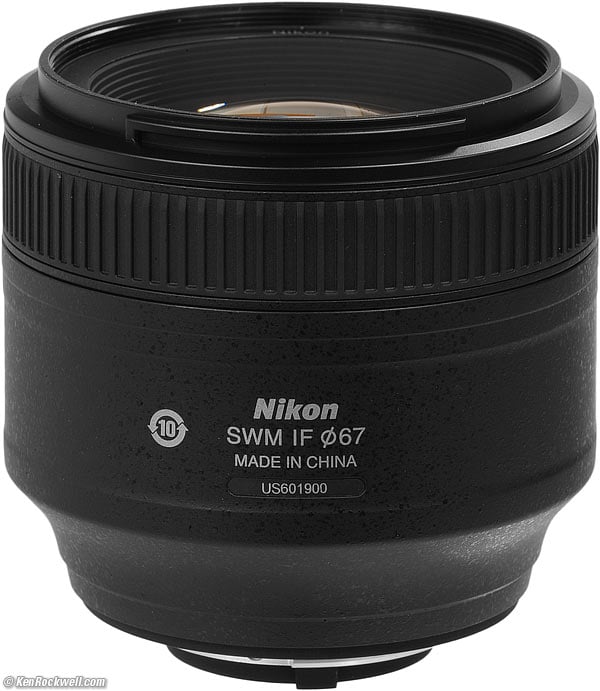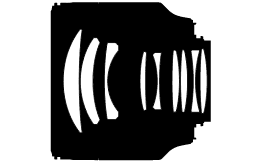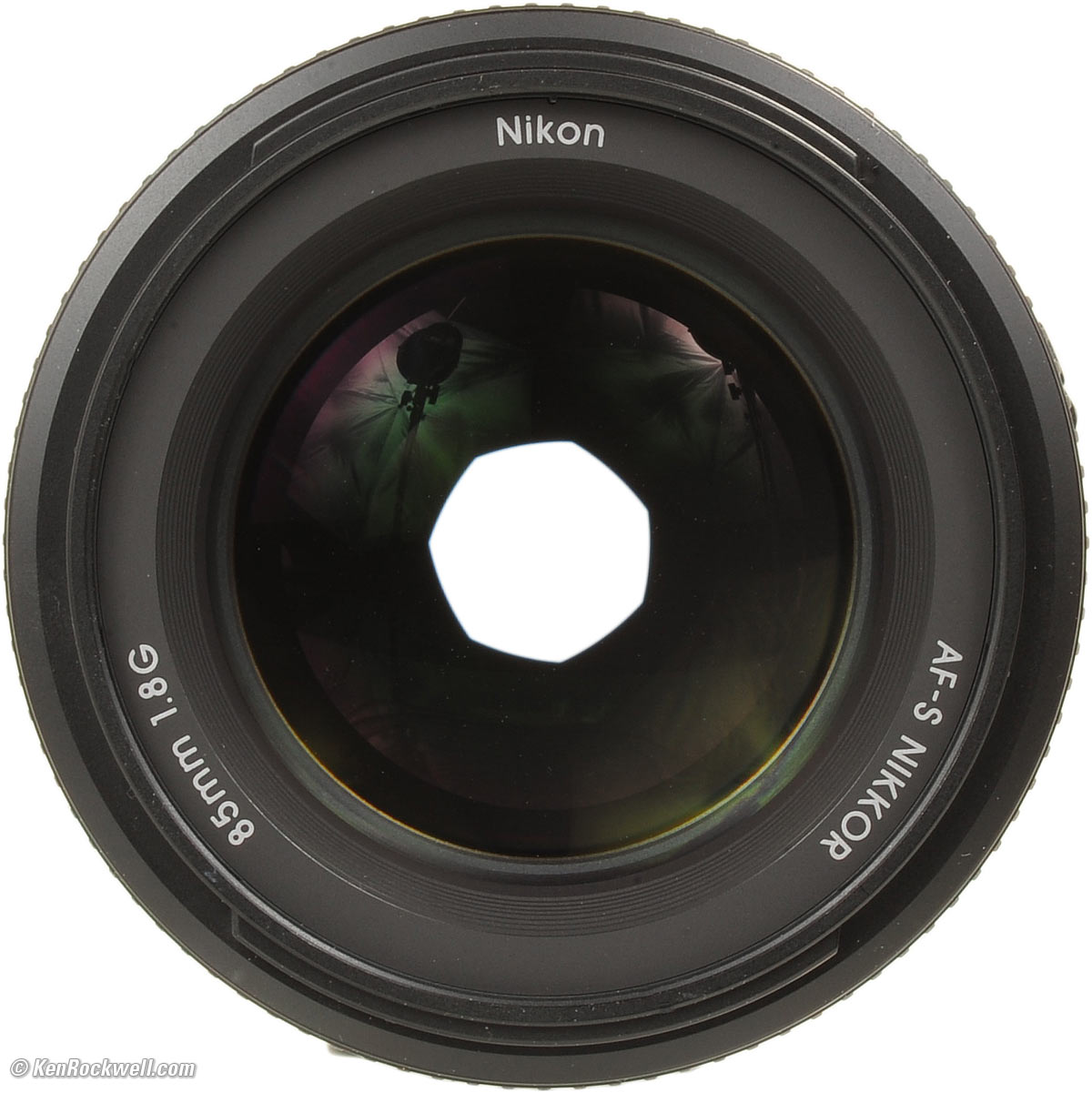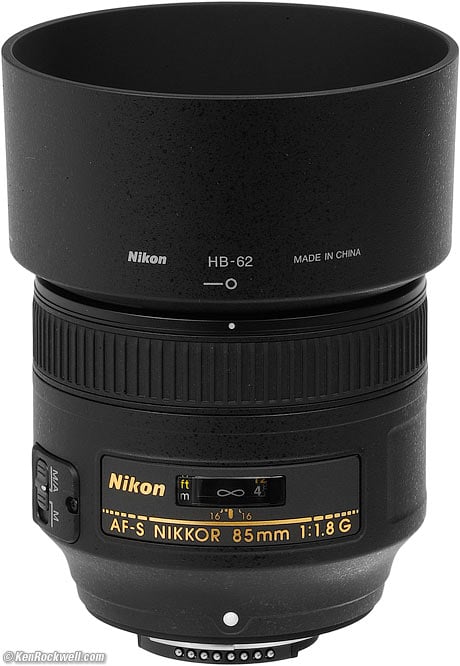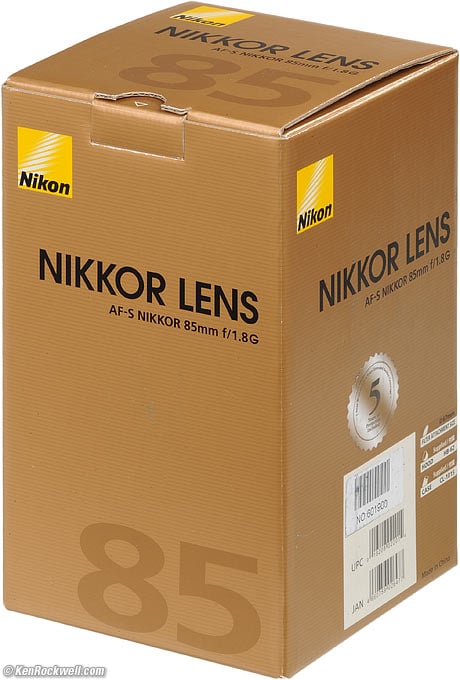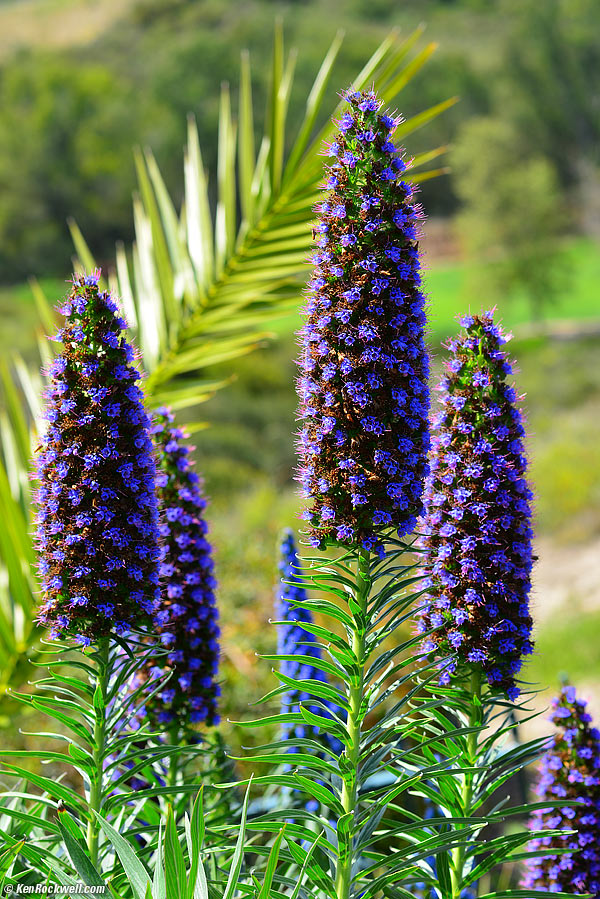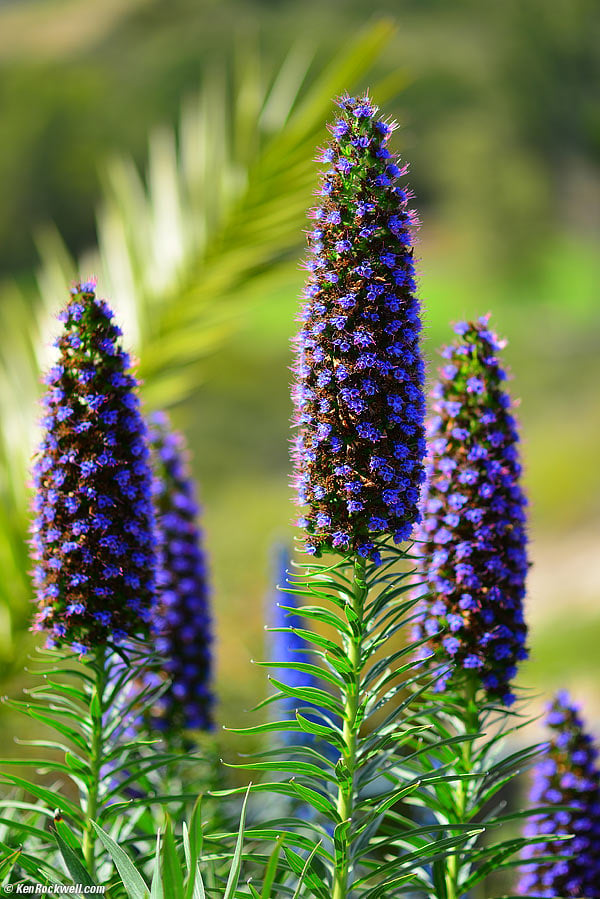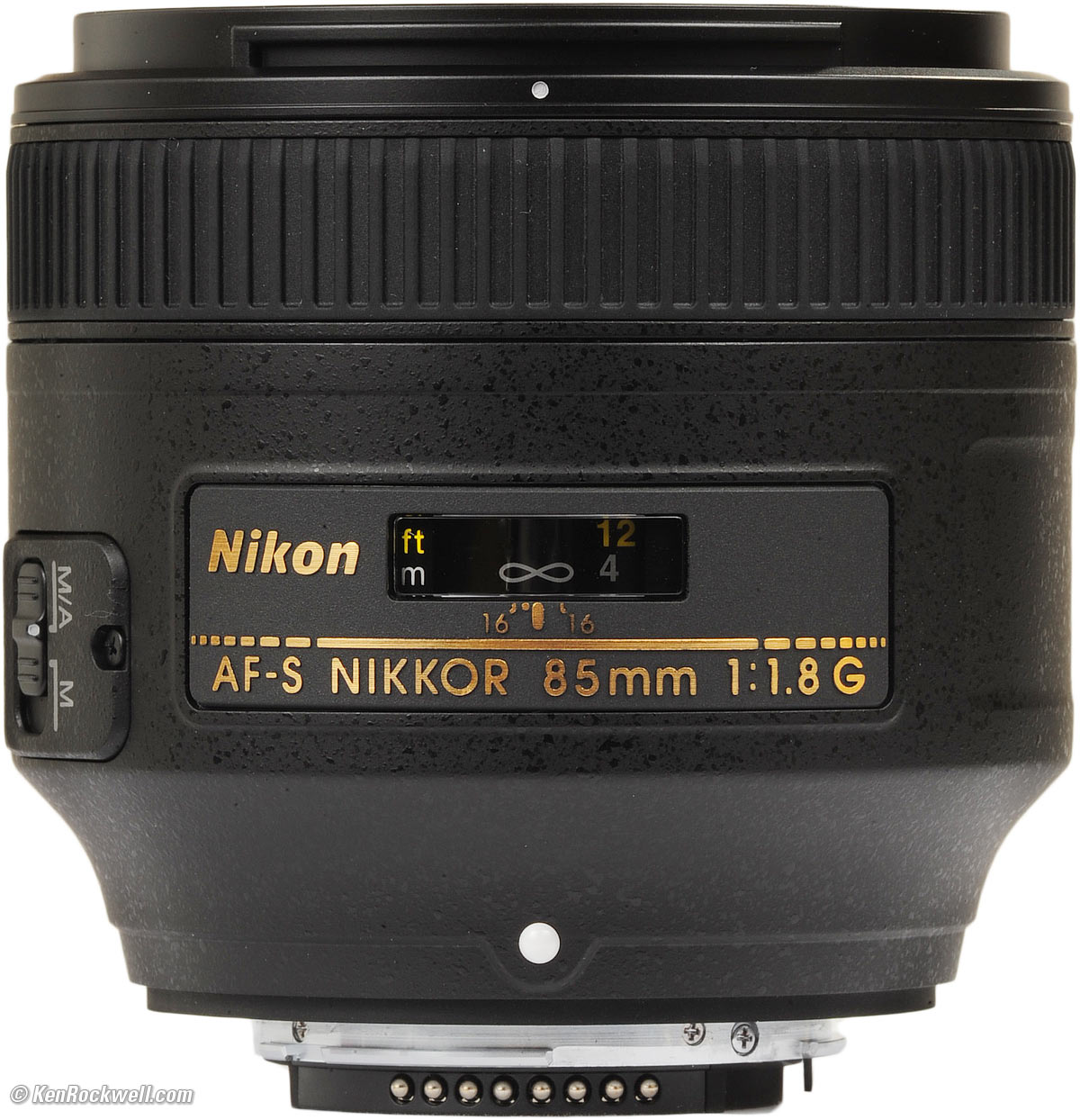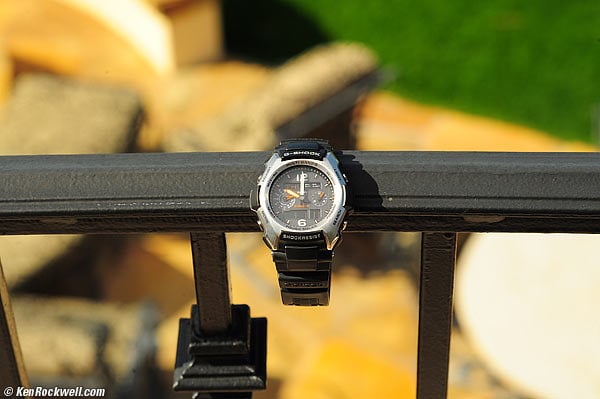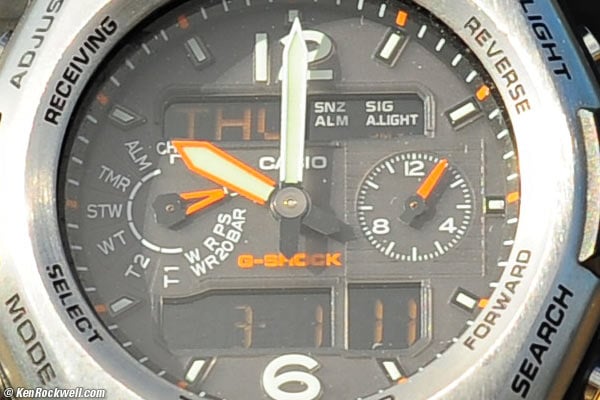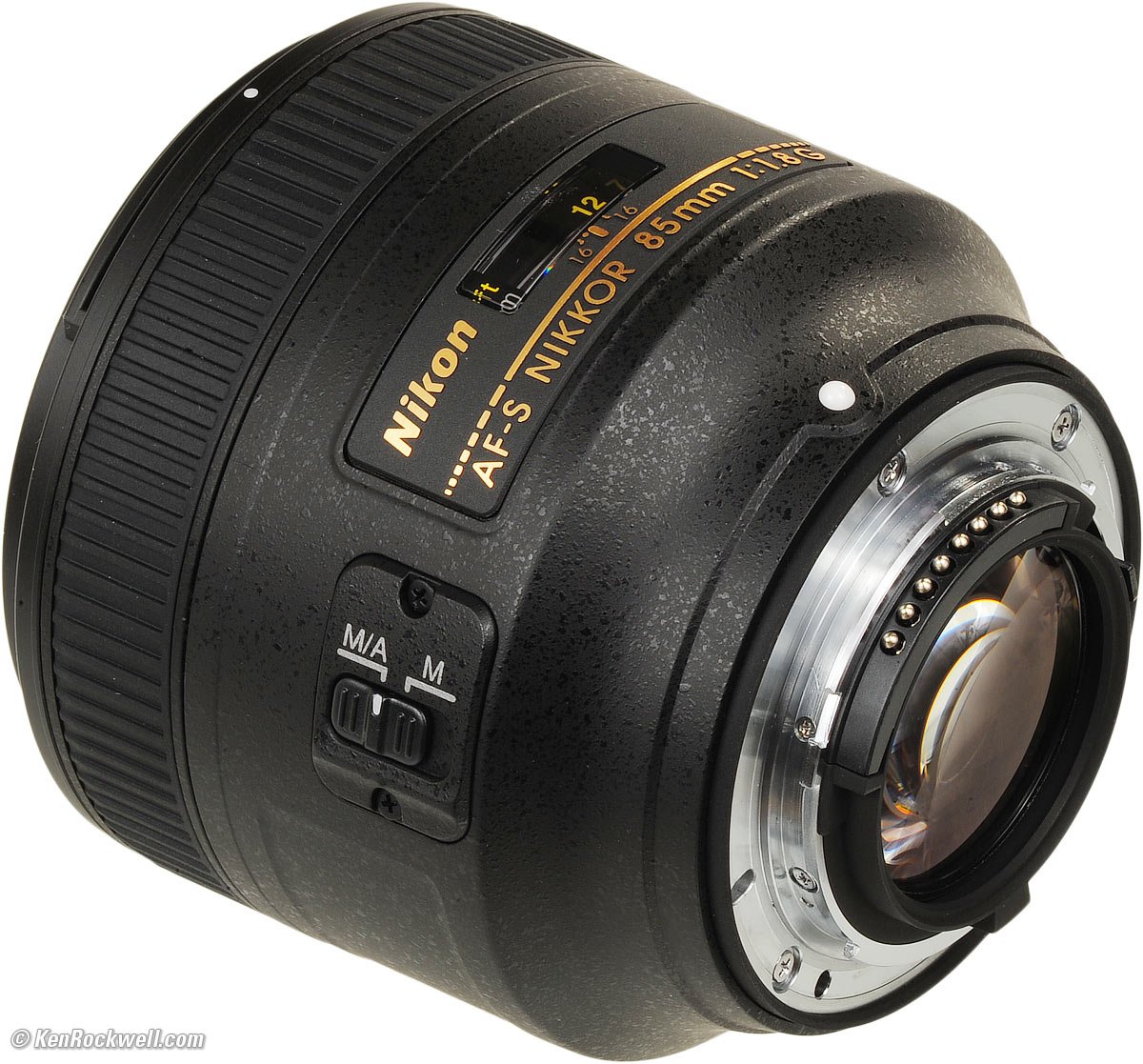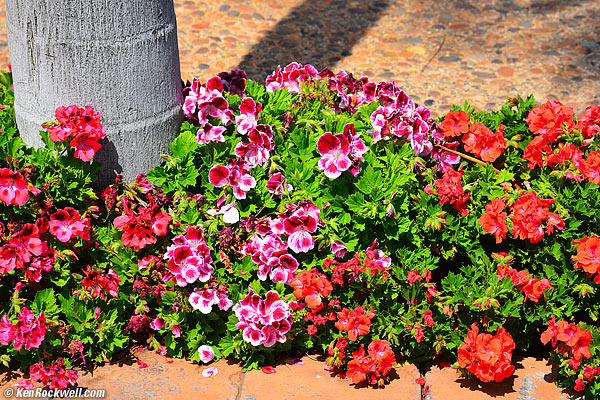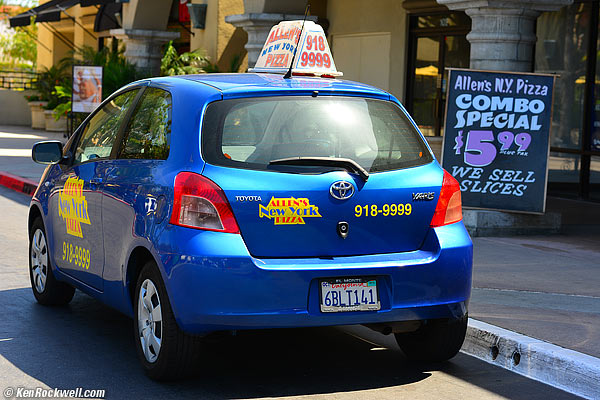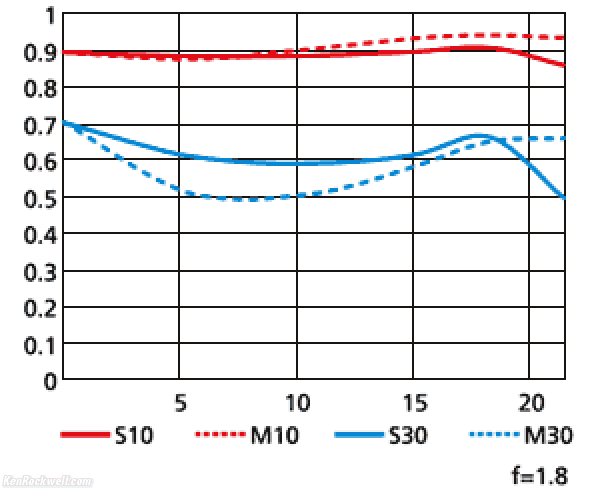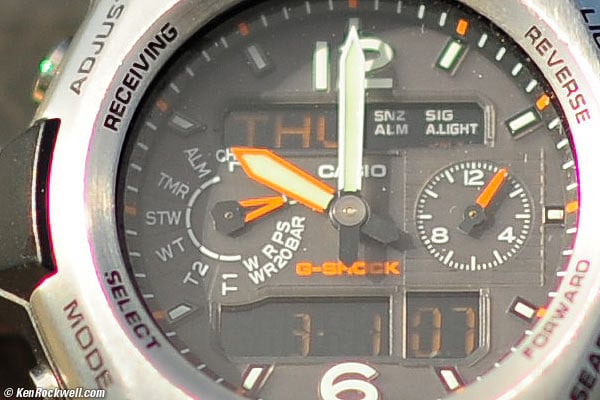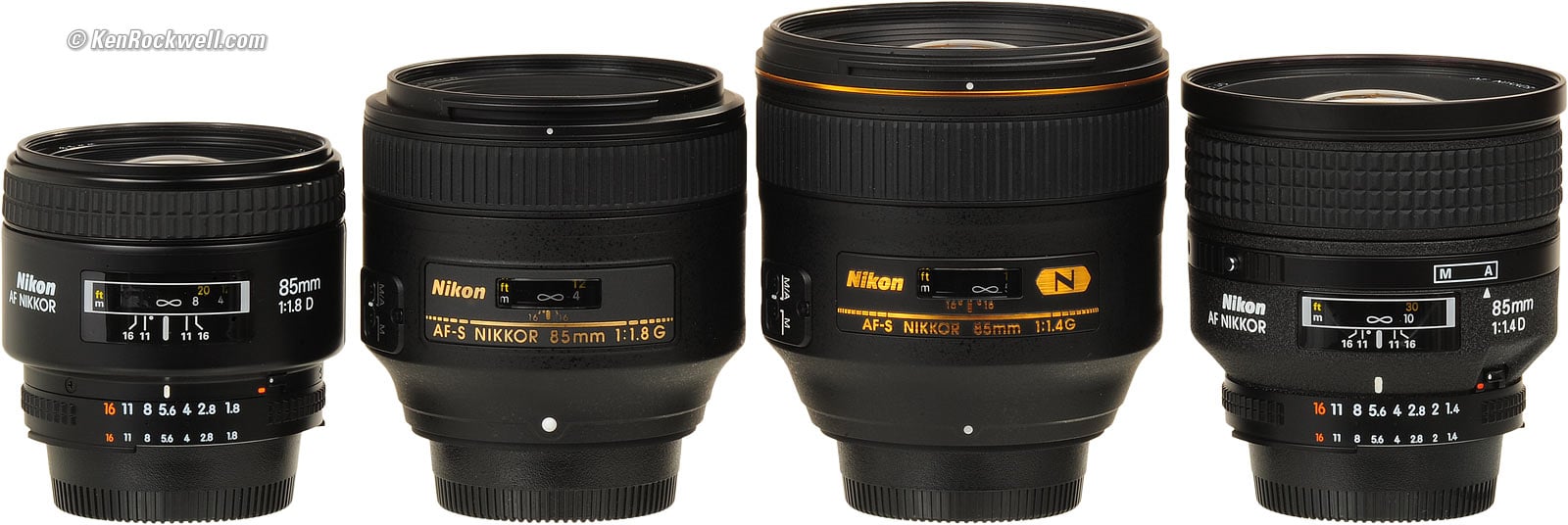Home Donate New Search Gallery Reviews How-To Books Links Workshops About Contact
Nikon 85mm f/1.8 G
AF-S NIKKOR (2012-)
NEW: Nikon Z 85mm f/1.8 (2019-)
Intro Specifications Performance Compared Recommendations More
Nikon 85mm f/1.8 AF-S G (67mm filters, 12.4 oz./351g, 2.6'/0.8m close focus, $427 new or about $325 used if you know How to Win at eBay). enlarge. I got mine at Adorama. You also can get it at Amazon and at B&H.
This all-content, junk-free website's biggest source of support is when you use those or any of these links to approved sources when you get anything, regardless of the country in which you live. Thanks for helping me help you! Ken.
November 2019 Better Pictures Nikon Reviews Nikon Lenses Nikon Manual-Focus Lenses All Reviews
Why Fixed Lenses Take Better Pictures
See also:
Nikon 85mm f/1.8 AF and AF-D (1987-).
Nikon 85mm f/2 (1977-1995).
Nikon 85mm f/1.8 (1964-1977).
| Optics: | |
| Mechanics: | |
| Ergonomics: | |
| Usefulness: | |
| Availability: | |
| Overall: |
Introduction top
Intro Specifications Performance Compared Recommendations More
|
I buy only from these approved sources. I can't vouch for ads below. |
This Nikon 85mm f/1.8 G is the sharpest 85mm lens ever made by Nikon, sharper on the D800 than even the extraordinary 85mm f/1.4 G, and Nikon's been making 85mm lenses since 1949. On the D800 in the laboratory, it's also slightly sharper than the original and still current 85mm f/1.8 AF-D.
This new 85mm's optics are the best ever from Nikon, but the mechanics are the cheapest: it's the first 85mm Nikon lens ever made with a plastic focus ring or made in China.
Compared to the original 85mm f/1.8 AF-D, this new G lens loses a half-ounce (15g) and adds instant manual-focus override and the ability to autofocus even on the cheapest DSLRs, but loses a lot of metal, replaces the 9-blade diaphragm with only 7 blades, and loses any compatibility with manual-focus 35mm cameras.
This new 85mm f/1.8G is a superb lens; I've been whining about Nikon cheapening the mechanics of each successive line of lenses since the 1980s, even though the optics have always gotten better and better.
Everything works perfectly on every digital Nikon ever made, both FX and DX, from the best D4, D800 and D800E to Nikon's cheapest digitals like the D40, D40x, D60, D3000, D3100, D5000 and D5100.
It's also perfect on decent or recent AF film cameras like the F6, F100, F5, N80 and N75.
The incompatibilities for older or cheaper 35mm cameras are that:
1.) It won't autofocus with the cheapest new AF 35mm cameras like the N55, but if you focus manually, everything else works great. Even if you lose autofocus, these cameras have in-finder focus confirmation dots to help you.
2.) Late 1980s ~ early 1990s AF cameras like the N90s, N70 and F4 will focus just fine. You'll have Program and Shutter-priority modes, but lose Manual and Aperture-priority since you have no way to set the aperture on the camera or on the lens.
3.) You're really pushing it with the oldest AF cameras like the N2020, N6006 and N8008. You'll have no AF and confused exposure modes. Manual focus is fine, along with electronic focus indications.
4.) Since it has no aperture ring, it's just about useless with manual focus film cameras. It will shoot every shot at its minimum aperture.
See Nikon Lens Compatibility for details with your camera. Read down the "AF-S, AF-I" and "G" columns for this lens. You'll get the least of all the features displayed in all columns, since "G" (gelding) is a deliberate handicap which removes features.
Nikon 85mm f/1.8 AF-S G. enlarge.
Specifications top
Intro Specifications Performance Compared Recommendations More
Name top
Nikon calls this the Nikon AF-S NIKKOR 85mm f/1.8G.
NIKKOR: Nikon's brand name for all their lenses.
AF-S and SWM: Silent Wave Autofocus Motor.
G: Gelded for cost-reduction and removing compatibility with older cameras.
IF: Internal focusing; nothing moves externally as focused.
∅67: 67mm filter thread.
↓10↑: 10-year expected life before being thrown away.
MADE IN CHINA: Offshored to save manufacturing cost.
US601900: Serial number. "US" means imported by Nikon USA.
Optics top
Internal diagram.
9 elements in 9 groups.
No ED glass, no aspherics, no fancy stuff needed.
Internal focus: nothing moves externally as focused.
It seems an internal group carries the diaphragm with it as focused.
It's multicoated, which Nikon calls Nikon Integrated Coating.
Diaphragm top
Nikon 85mm f/1.8 AF-S G at f/5.6. enlarge.
7 somewhat rounded blades, a big downgrade from the 9 straight blades of the 85mm f/1.8 AF-D.
Stops down to f/16.
Focal Length top
85mm.
When used on a DX camera, it gives angles of view similar to what a 129mm lens gives when used on an FX or 35mm camera.
Angle of View top
28.5° diagonally on FX and RealRaw.
(18.8º on small-format DX, 22.8º on Pronea APS.)
Close Focus top
2.6 feet (0.8m).
Maximum Reproduction Ratio top
1:8.1.
Hard Infinity Focus Stop? top
No.
You have to let the AF system focus at infinity.
The older 85mm f/1.8 AF-D does have an infinity focus stop.
Focus Scale top
Yes, but abbreviated.
Depth-of-Field Scale top
No, but there are two meaningless little vestigial tits for f/16.
Infra-Red Focus Index top
Yes, a microscopic gold dot between the left "16" mark and the focus scale index.
Aperture Ring top
No; it was removed to save cost.
Filter Thread top
67mm, plastic.
Does not move, ever.
Size top
Nikon specifies 80mm (3.1") diameter by 73mm (2.9") extension from flange.
Weight top
12.390 oz. (351.3g), measured.
Nikon specifies 12.4 oz. (350g).
Hood top
Nikon 85 1.8 G and HB-62 hood.
Plastic bayonet HB-62 hood, included. Dull black inside, no fuzz and no ridges.
The older 85mm f/1.8 AF-D includes a metal hood.
Bag top
CL-1015 sack included, but a used sock works better.
Included top
Excellent snap-on LC-67 67mm front lens cap.
LF-4 rear cap, the newest version that covers a bit more of the flange to keep off dust.
HB-62 plastic hood.
Printed instruction book in twenty languages.
Quality top
Made in the People's Republic of China.
HB-62 hood: Made in the People's Republic of China.
LR-4 rear cap: Made in Thailand.
LC-67 front cap: Made in Thailand.
Instruction book: printed in the People's Republic of China.
Teleconverters top
None recommended.
Packaging top
Box, Nikon 85mm f/1.8 AF-S G.
Gold-colored microcorrugated cardboard box.
Lens and hood supported in foggy polypropylene cradle.
Paperwork slipped-in along the side.
Announced top
06 January 2012.
Available since top
Late February 2012.
Nikon Product Number top
2201.
Price, USA top
$427 new or about $325 used if you know How to Win at eBay, July~Novemebr 2019.
$500 at introduction, January 2012 through May 2013.
Performance top
Intro Specifications Performance Compared Recommendations More
Overall Autofocus Bokeh Color Coma Distortion
Ergonomics Eyeblow Falloff Filters Focus Breathing
Ghosts Lateral Color Fringes Macro Mechanics
Sharpness Spherochromatism Sunstars Survivability
Overall performance top
The Nikon 85mm f/1.8 AF-S G has stellar optical quality in a good, consumer-grade package.
Autofocus performance top
Overall
AF works great.
AF Speed
AF speed is as we expect. It's a little slower than the 85mm f/1.8 AF-D, and the same to maybe a little faster than the 85mm f/1.4 G.
AF Accuracy
AF is fine, even at f/1.8. No problems here, but of course you need to be vigilant about having your AF sensor accurately pointed where you want focus.
On the Nikon D800 at 36 MP at f/1.8, it's usually right on.
Manual Focus
Manual focus is fine.
Grab the ring at any time for instant manual-focus override, unlike the previous 85mm f/1.8 AF-D which requires moving a switch on the camera.
M/A - M Switch
Nikon goofed. This switch is supposed to be labeled "A - M."
The "M/A" position means autofocus. It's called "M/A" because you also can focus manually simply by grabbing the focus ring in this position.
The "M/A" position means autofocus. It's called "M/A" because back in the old days, when Nikon had almost caught up to Canon who had been doing this for ten years before, Nikon was trying to show off that you could focus manually while in the AF position.
Paint over the extra M if you're easily confused.
Bokeh performance top
Bokeh, the character of out of focus backgrounds, not simply how far out of focus they are, is pretty good, maybe slightly better than the 85mm f/1.8 AF-D, but nothing's quite as good as the 85mm f/1.4 G.
ISO 3,200 Bokeh
Sushi. 85mm f/1.8 G, Nikon D800, f/1.8 at 1/100, AUTO ISO chose ISO 3,200, VIVID +3 Saturation, Sharpening set to 6. Camera-original © LARGE BASIC Optimum Quality JPG file.
Warning: Almost nothing is in focus.
Vertical Bokeh
Dildoplant. 85mm f/1.8 G, Nikon D800, f/6.3 at 1/160, ISO 100, VIVID +3 Saturation, Sharpening set to 6. LARGE BASIC Optimum Quality JPG file (losslessly rotated in iView 3.1.3).
Warning: Almost nothing is in focus.
Dildoplant. 85mm f/1.8 G, Nikon D800, f/1.8 at 1/1,600, ISO 100, VIVID +3 Saturation, Sharpening set to 6. LARGE BASIC Optimum Quality JPG file (losslessly rotated in iView 3.1.3).
Warning: Almost nothing is in focus.
Here now are crops from the center of 100% FX 12MP (D3 or D700) images, focused on a reference phase lattice at 3 meters (10 feet) with synthetic reference vegetation at 15 meters (50 feet). Printed full-image at this size, these would be about 42 x 28" (105 x 70cm) prints, at least as seen on most 100 DPI computer monitors:
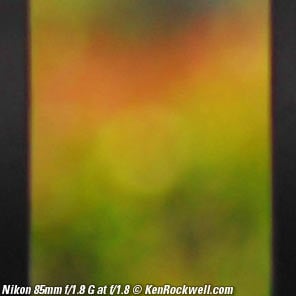 |
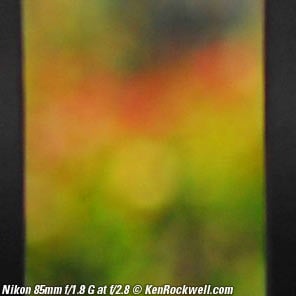 |
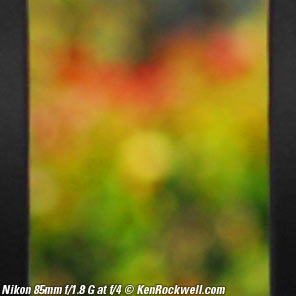 |
 |
Color Rendition performance top
The color rendition is the same as my other Nikkor AF lenses.
Coma performance top
Just like the 85mm f/1.8 AF-D, I can't see any significant coma.
Coma (saggital coma flare) often causes weird smeared blobs to appear around bright points of light in the corners of fast or wide lenses at large apertures. In lenses that have it, coma goes away as stopped down.
Distortion performance top
The Nikon 85mm f/1.8 AF-S G has no visible distortion.
It has a tiny bit of barrel distortion which can be corrected for critical use by plugging these figures into Photoshop's lens distortion filter. (The 85mm f/1.8 AF-D has no distortion). These aren't facts or specifications, they are the results of my research that requires hours of photography and calculations on the resulting data.
FX and Film |
|
∞ |
-0.5 |
30' (10m) |
-0.5 |
10' (3m) |
-0.5 |
3' (1m) |
-0.5 |
© 2012 KenRockwell.com. All rights reserved.
Ergonomics (handling and ease-of-use) performance top
Nikon 85mm f/1.8 AF-S G. enlarge.
Ergonomics are perfect, except for the all-plastic feel. I'd rather have metal in my hands, but otherwise, this and its bigger brother the 85mm f/1.4 G have perfect ergonomics.
Eyeblow performance top
Nothing moves except for an internal optical group as focused, so there is no air blow out of the eyepiece into your eye. This is common with zooms while zooming.
Falloff (darkened corners) performance top
Falloff on FX is visible at f/1.8 and f/2, and gone by f/2.8.
It won't be an issue at all on DX (see crop factor).
I've exaggerated this by shooting a gray field and placing these on a gray background.
Nikon 85mm f/1.8 AF-S G falloff on FX and film at infinity, no correction.
© 2012 KenRockwell.com. All rights reserved.
|
Filters, use with performance top
There is no problem with vignetting, even with combinations of thick filters.
The filter ring never moves.
Focus Breathing performance top
Of interest mostly to cinematographers focusing back and forth between two subjects, the image from the Nikon 85mm f/1.8 AF-S G gets slightly larger as focused more closely.
The 85mm f/1.8 AF-D has much less.
Ghosts performance top
I could excite no ghosts and no flare.
Lateral Color Fringes performance top
There are no lateral color fringes on the D800, D3 or D7000 on which I tested it. These cameras correct these fringes automatically.
There is some spherochromatism, which is a different aberration.
Macro performance top
Nikon 85/1.8G at closest focus distance at f/9, full-frame.
600 x 400 pixel crop from above 12MP Nikon D3 JPG shot.
Macro is the same as just about every other SLR lens.
It doesn't get as close as many zooms and certainty nowhere near as close as a real macro lens, but is it very sharp, even wide-open at f/1.8.
Mechanics and Construction performance top
Rear, Nikon 85mm f/1.8 AF-S G. enlarge.
The Nikon 85mm f/1.8 AF-S G is made to good consumer standards in China. The 85mm f/1.8 AF-D is much better mechanically.
Filter Threads
Plastic.
Hood
Plastic bayonet.
Hood Mount
Plastic.
Barrel Exterior
Plastic.
Focus Ring
Plastic; rubber covered.
Focus Helicoids
Feel like plastic.
Depth-of-Field Scale
Not really.
Internals
Mostly plastic.
Aperture Ring
None.
Mount
Dull-chromed brass.
Markings
Paint.
Mounting Index Dot
White plastic ball.
Identity
Debossed gold-look plastic plate on barrel.
Numbers printed on front ring.
Serial Number
Sticker glued into a recess on the bottom of the lens.
US Model Signified by
"US" prefix to serial number.
Rain seal at mount
Yes.
Noises When Shaken
Mild clunking.
Made in
China.
Weaknesses
Nikon's AFS autofocus motors break. I've had a couple die on me, and if this lens dies and Nikon decides no longer to supply repair parts, you've got a manual-only focus lens.
Sharpness performance top
Warning 1: Image sharpness depends more on you than your lens.
Warning 2: Lens sharpness doesn't mean much to good photographers.
With those caveats, the Nikon 85mm f/1.8 AF-S G is ultra-sharp edge-to-edge at every aperture, especially on the 36 MP Nikon D800.
On the D800 at 36 MP, the 85mm f/1.8 AF-D and 85mm f/1.4 G are slightly softer at the largest apertures.
Of course diffraction limits performance at smaller apertures.
Flowers. 85mm f/1.8 G, Nikon D800, f/7.1 at 1/200, ISO 100, VIVID +3 Saturation, Sharpening set to 6. Camera-original © LARGE BASIC Optimum Quality JPG file.
Warning: Very little is in perfect focus.
Spongebob
West Los Angeles. 85mm f/1.8 G, Nikon D800, f/6.3 at 1/160, ISO 100, VIVID +3 Saturation, Sharpening set to 6. Camera-original © LARGE BASIC Optimum Quality JPG file.
Warning: Very little is in perfect focus.
Nikon's 85 1.8 G MTF curve, wide-open at f/1.8.
Nikon's claimed MTF supports what I've seen: stunning sharpness from edge-to-edge on full-frame, even wide-open. Getting perfect focus is critical; if you see green or magenta color fringes, that tells you that you're not in perfect focus.
Spherochromatism performance top
Spherochromatism, sometimes mistakenly called "color bokeh" by laymen, is a minor aberration which can add slight color fringes to out-of focus highlights.
Fast, long lenses often show spherochromatism, which is when out-of-focus highlights take on slight color fringes. Laymen sometimes mistakenly call spherochromatism "color bokeh."
Tight crop from 100% D3 image at close-focus distance at f/1.8.
Spherochromatism is what's causing the highlights on the rear buttons to flare green, and the highlights on the closer bezel to flare magenta.
Stopped down, this goes away.
Sunstars performance top
With its rounded 7-bladed diaphragm, the Nikon 85 1.8G sometimes makes broadly muted 14-pointed sunstars on bright points of light.
The conventional 9-bladed diaphragm of the 85mm f/1.8 AF-D makes far superior sunstars.
Survivability performance top
The Nikon 85mm f/1.8 AF-S G uses an AFS autofocus motor, and they break.
I've had a couple die of other Nikon AFS lenses die on me, so if this lens' internal AF motor dies, it's got to go in for repair.
If Nikon decides no longer to supply repair parts, you'll have a manual-only focus lens.
Compared top
Intro Specifications Performance Compared Recommendations More
Nikon 85/1.8D, 85/1.8G, 85/1.4G and 85/1.4D. enlarge.
I've been making comparisons to the original 85/1.8D, and the larger 85/1.4G throughout this review.
See also 85mm Lens Specifications Compared.
This is the sharpest 85mm ever made by Nikon and it has no visible distortion, however it's plasticy.
Recommendations top
Intro Specifications Performance Compared Recommendations More
The Nikon 85mm f/1.8 AF-S G is a wonderful lens, and so is the original 85/1.8D.
If you intend to use this new lens on one of Nikon's cheaper DSLRs that lacks its own AF motor, get this 85/1.8 G lens.
If you want instant manual-focus override, get this lens or the 85/1.4 AFS-G.
If you want a tougher, more precise-feeling 85mm f/1.8 for the same price or less, get the 85/1.8D.
If you want an 85mm with incredible ability to blur backgrounds and keep the subject ultrasharp, the extraordinary 85/1.4G is even better than this 85mm G.
If you need the sharpest possible lens for use on the Nikon D800 and D800E, get this f/1.8G lens.
This is a lens to get if you don't have an 80-200/2.8 zoom. The zooms tends to be almost as sharp and almost as fast, so don't ever carry both at the same time.
I love any 85/1.8 as a fast prime portrait lens or general-purpose fast, short tele at a reasonable price. It's the one fixed tele I'd grab along with a wide lens for day-to-day shooting.
If you own the 28-300mm VR, forget any fixed lenses in this range; you'll probably never pull out a fixed 85 if you have the zoom.
If you have a zoom and want a lens to blow-out backgrounds into smooth, soft colors at a reasonable price, shoot your zoom at 200~300mm, and you'll get the same effect or better than an 85mm lens at f/1.8. If you want a fixed tele for blurring backgrounds at a reasonable price, get a manual-focus 135mm f/2 or 180mm f/2.8 instead. Longer focal length has much more to do with blurring backgrounds than maximum aperture.
If you want a lightweight, super-sharp general-purpose carry everywhere medium tele, this new 85/1.8 G is a great lens for just about everything.
If you've found all the time and expense I've incurred creating and sharing this review for free, this website's biggest source of support is when you use these links, especially this link directly to this lens at Adorama and at Amazon when you get anything, regardless of the country in which you live. Thank you! Ken.
Deployment
I'd leave either a 67mm Nikon Clear (NC - UV) filter, or a 67mm Hoya Super HMC UV on the lens at all times. I would leave the hood at home.
If I was working in nasty, dirty areas, I'd forget the cap, and use an uncoated 67mm Tiffen UV filter instead. Uncoated filters are much easier to clean, but more prone to ghosting.
For color slides like Velvia 50, I use a 67mm Hoya HMC 81A outdoors.
For B&W film outdoors, I'd use a 67mm Hoya HMC K2 Yellow or 67mm Hoya HMC Orange.
Honestly, I'd get a 67mm -> 77mm step-up ring, and treat this lens as a 77mm-threaded lens from now to eternity. This will save you a lot of aggravation, unless you really plan to build a system around 67mm filters.
More Information top
Intro Specifications Performance Compared Recommendations More
Help me help you top
I support my growing family through this website, as crazy as it might seem.
The biggest help is when you use any of these links when you get anything, regardless of the country in which you live. It costs you nothing, and is this site's, and thus my family's, biggest source of support. These places have the best prices and service, which is why I've used them since before this website existed. I recommend them all personally.
If you find this page as helpful as a book you might have had to buy or a workshop you may have had to take, feel free to help me continue helping everyone.
If you've gotten your gear through one of my links or helped otherwise, you're family. It's great people like you who allow me to keep adding to this site full-time. Thanks!
If you haven't helped yet, please do, and consider helping me with a gift of $5.00.
As this page is copyrighted and formally registered, it is unlawful to make copies, especially in the form of printouts for personal use. If you wish to make a printout for personal use, you are granted one-time permission only if you PayPal me $5.00 per printout or part thereof. Thank you!
Thanks for reading!
Mr. & Mrs. Ken Rockwell, Ryan and Katie.
Home Donate New Search Gallery Reviews How-To Books Links Workshops About Contact
